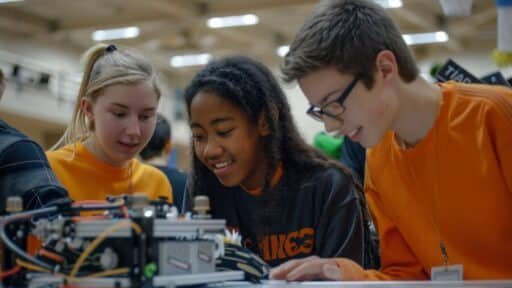Technology In Shaping Education Degree In today’s fast-changing world, technology is changing how we learn. It’s making education more personalized and easier to access for students worldwide. We see this change in online platforms and virtual classrooms, creating new ways to learn that are more engaging and personalized than ever before.
Now, learning is not limited to a classroom. With tools like Khan Academy, MOOCs, and podcasts, learning can happen anytime, anywhere. This change means that you can take more control of your learning journey. It lets you explore and share knowledge in ways you might not have thought possible.
Also Read: How To Choose The Best Education Degree Program For Your Goals?
New tech like AI, VR, and AR is also changing education. It’s making learning more interactive and immersive, which is great for keeping students interested. It also helps teachers meet students where they are, adapting lessons to different learning styles and needs.
This transformation in learning is just beginning. As we move forward, it’s important for schools, leaders, and others involved in education to use these tools wisely. They should help ensure that everyone gets a chance to learn in a way that prepares them for the future job market. By using technology well, we can help students do better in school and later in their careers.
Key Takeaways
- Technology has greatly expanded access to education, enabling a new “age of anytime anywhere education” through online learning platforms and resources.
- Emerging technologies, such as artificial intelligence, virtual reality, and augmented reality, are transforming the educational landscape, offering more personalized, interactive, and engaging learning experiences.
- The integration of technology in education promotes inclusivity, equity, and the development of future-ready skills, preparing students for the demands of the digital age.
- Educators and educational institutions must embrace the transformative power of technology to enhance the learning experience and foster student success.
- Effective integration of technology in education requires a strategic and holistic approach to address infrastructure, teacher training, and data privacy concerns.
Also Read: The Ultimate Degree: Navigating The Path To The Highest Level Of Education
Transforming Access to Education
Online learning platforms are changing how we see education. They give people all over the world a chance to learn new things. Sites like Khan Academy, Coursera, and edX offer many educational resources. And they’re open to everyone, no matter where they live or how much money they have.
Also Read: Education Programs At The American College Of Education
Massive Open Online Courses (MOOCs)
Massive Open Online Courses (MOOCs) are leading this change. They provide top-notch educational opportunities for free or at a low cost. Many well-known schools and institutions support these online learning platforms.
Through MOOCs, anyone can access world-class educational resources. This helps bridge the gap between different places and people. It means everyone can have personalized learning experiences.
Also Read: Specialized Teaching Strategies: The Benefits Of A Masters In Special Education
Virtual Classrooms
Virtual classrooms are another big step forward. They let students join in on interactive learning anywhere with an internet connection. This makes education more available and brings people from different backgrounds together. It creates a more diverse learning community.
Also Read: Advancing Inclusive Education: The Value Of A Master In Special Education
Enhancing Collaboration and Communication

Now, technology changes how students and teachers work together and talk, no matter where they are in the world. Communication tools bring an age of virtual collaboration. This means students can join online talks and work together on projects with friends from around the globe.
Global Connectivity
Thanks to technology, students can explore far-off places by working with others. They can share info and even talk with scientists out in the field. This connectivity broadens their view of the world and helps them see things from different angles.
Collaborative Learning Tools
Tools like wikis and Google Docs have changed how students team up on projects. These tools let them work together, no matter where they are. It helps make communication instant and improves teamwork in ways only dreamed of before.
Redefining Teacher and Student Roles
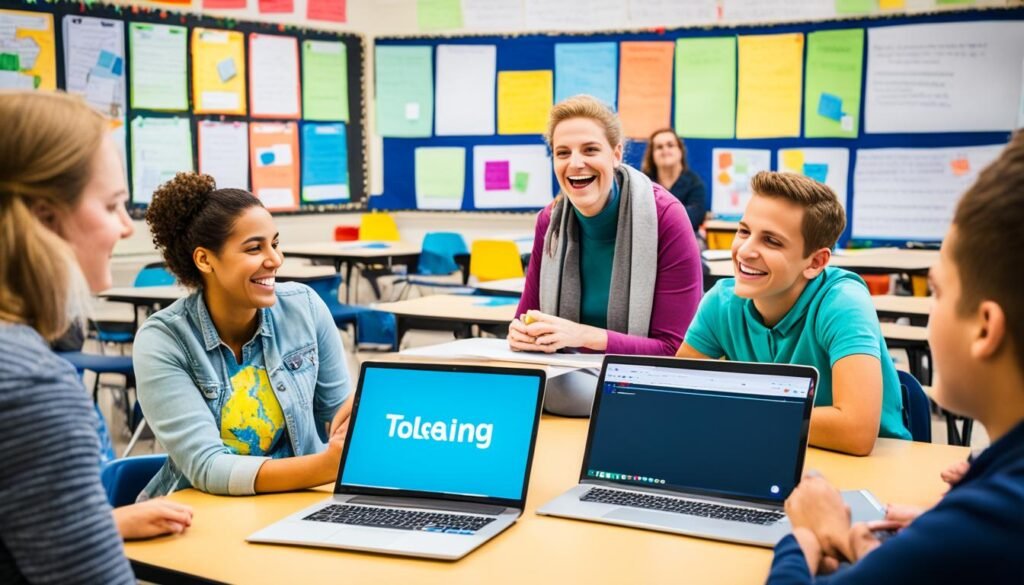
Technology is changing how we see the roles of teachers and students. The teacher is no longer just a source of information. They are a “guide on the side.” Students are now taking more responsibility for their learning. They use technology to find information on their own. This change is known as student-centered learning. It encourages active learning and engaging online experiences.
Teacher as a Guide
The role of the teacher is very important in this new setup. Instead of being the only source of knowledge, they now guide students. They help students explore and find information using technology. Teachers support students as they discover new things.
Student-Centered Learning
Technology is making students the focus of learning. Now, students do more than just listen in class. They get to explore and engage with what they learn. They also get to work together more. This way, students improve their critical thinking and problem-solving skills. They also feel more in charge of their learning.
Fostering Interactive and Engaging Learning
Technology has changed how we learn. It makes learning more fun and effective. Teachers use the latest tools to grab students’ attention and help them learn better. Let’s look at some key tech that’s changing education.
Multimedia Resources
Today, students can use things like interactive videos and virtual field trips. These tools make learning fun and deep. They get students to join in, understand better, and stay curious. This makes learning more engaging and enjoyable.
Gamification
Adding game-like features to learning, or gamification, is a hit. It uses points and badges to keep students interested. This boosts how fun and motivating learning is. Students stay engaged and work harder in their studies.
Virtual Reality and Augmented Reality
Virtual reality (VR) and augmented reality (AR) are making learning awesome. Students can visit any place or do any experiment through a screen. These new ways to learn are more fun and interactive. They could change how we do school trips and practical lessons.
Enabling Personalized Learning Experiences

Technology is changing how we learn, giving us personalized learning experiences. Adaptive learning technologies and learning analytics let teachers meet the needs of each student. This improves how we learn a lot.
Adaptive Learning Technologies
Adaptive learning technologies are making lessons better for everyone. They use data-driven education to see how students are doing. This helps find what students need to work on, customizing lessons for them.
Learning Analytics
Learning analytics, along with the tech, are key. They gather and study info on how students learn. This helps teachers adjust lessons and give feedback that’s just right for every student.
| Adaptive Learning Technologies | Learning Analytics |
|---|---|
| Utilize data-driven education to personalize instruction and cater to individual learning needs | Collect and analyze student performance data to inform curriculum design and provide tailored feedback |
| Adapt content, pacing, and activities to ensure each student receives the support and challenges they need | Provide valuable insights to help educators cater to individual needs and learning styles |
| Enable a more personalized learning experience that addresses the unique needs of each student | Empower data-driven decision-making to enhance the overall learning process |
Technology in Shaping Education Degree

Technology is changing how we learn, teach, and experience education. It’s transforming the education world in ways we never thought possible. This is the shaping the future of education we once only dreamed of.
Technology is doing a lot for education. It’s giving more people the chance to learn. It’s also creating ways for us to work together that we never had before. Now, technology in education is a big help in changing and improving how we learn anytime, anywhere.
Learning has changed a lot thanks to technology. There are online classes and places like virtual classrooms. Now, students can learn and work together from all over. They have more chances to learn cool things, no matter where they are.
Technology’s place in education keeps growing. It’s now a key part of learning and teaching. With more of this kind of technology in shaping education degree, we’re sure to see even more exciting changes in the future.
Streamlining Administrative Tasks
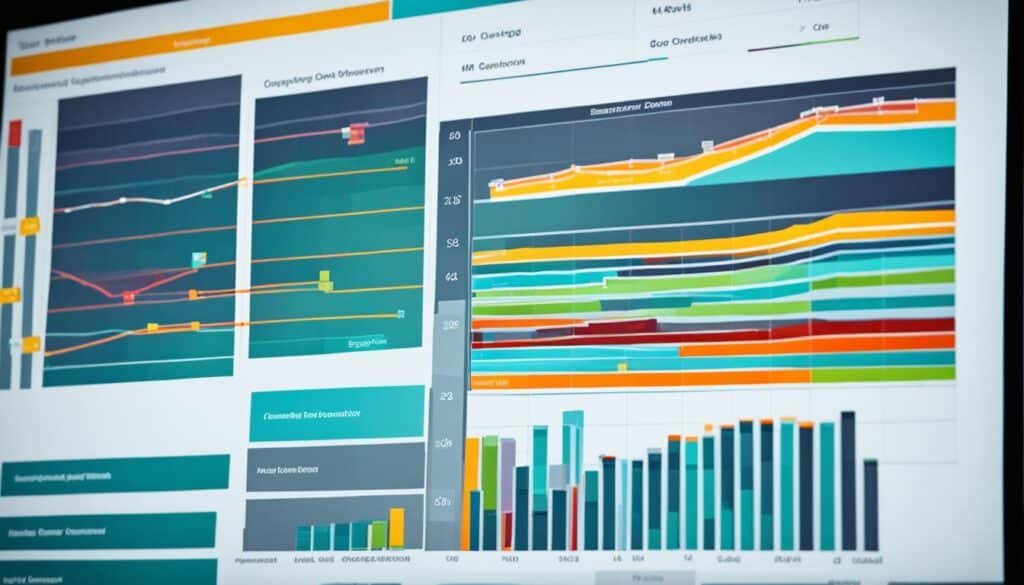
Technology is changing how schools handle their daily tasks. It’s making everything from grading papers online to keeping track of who’s in class easier. These digital tools help teachers and staff spend less time on paperwork. This lets them focus more on helping students learn.
Online Grading and Attendance Tracking
Using online grading and attendance systems means work gets done faster. These systems do all the hard work of sorting and checking student records. This lets educators put more effort into teaching. It also means less time spent on admin work for teachers.
Resource Management Systems
Resource management systems are also a big help. They bring all school resources, like books and computers, together in one place. By doing this, schools cut down on costs and make sure everyone has what they need.
Bridging the Digital Divide
Technology is changing how we learn, but not everyone has the same access. It’s important to close the bridge digital divide. This will help all students, no matter their background, get the access to technology and internet they need to do well today.
Access to Technology and Internet
Many students face challenges because they don’t have enough technology or internet access. This is especially true for those in low-income or rural areas. We need to fix this by making sure everyone has the gadgets they need, the internet to connect, and the support for using them.
Digital Literacy Initiatives
It’s not just about getting gadgets to everyone. We also need to teach digital literacy to those who might not be as familiar. This empowers marginalized communities and helps everyone get better with technology. By training both students and teachers, they can really use technology to learn.
Everyone coming together can make a big difference. Through teamwork between schools, the government, and groups in the community, we can close this digital gap. This way, every student has a fair chance to learn and gets ready to be a part of tomorrow’s workforce.
Preparing Students for the Future Workforce
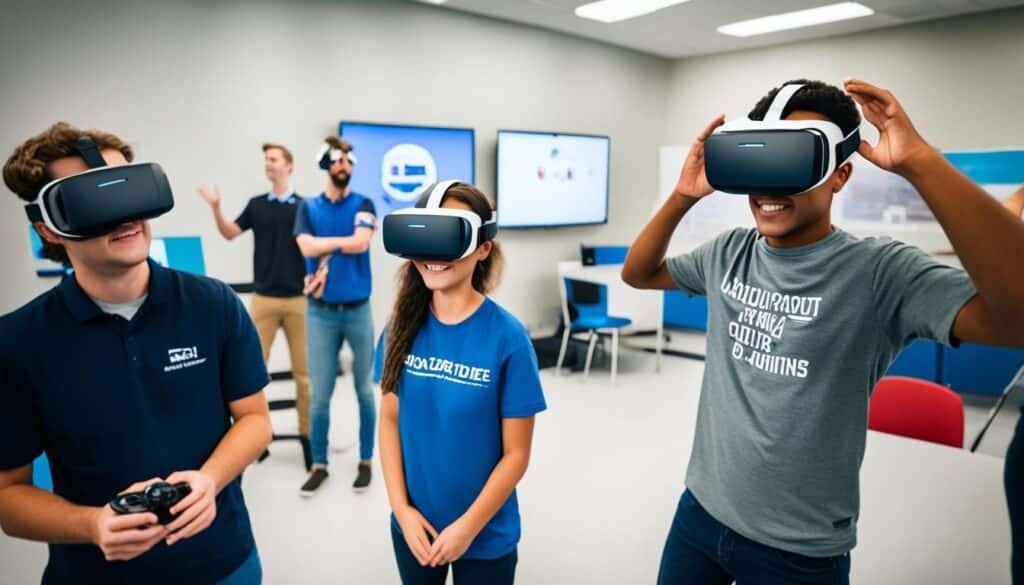
The world around us is changing fast. So, it’s vital to give students the skills they need. With tech in just about everything we do, knowing how to use and work with tech is crucial for success. These skills will prepare students for the jobs of tomorrow.
Digital Skills Development
Today’s students need to know their way around digital tools to get ahead. That means being good with stuff like software, data, and online communication. Knowing these things helps students keep up with tech changes and what future jobs might need.
Virtual Collaboration and Communication
The pandemic made working from home more common. Now students must become pros at working together online and solving problems. Learning to use video calls and teamwork tools makes it easier to fit the job market’s tech needs.
| Key Skills for the Future Workforce | How Technology Supports Development |
|---|---|
| Digital Literacy | Proficiency in using productivity software, data analysis tools, and communication platforms |
| Virtual Collaboration | Effective communication, teamwork, and problem-solving in virtual environments |
| Adaptability | Ability to quickly learn and apply new technologies to meet evolving job requirements |
| Critical Thinking | Leveraging data and technology to analyze complex problems and make informed decisions |
| Creativity | Using technology to come up with new ideas, make models, and create fresh solutions |
Teaching these future-ready skills to students is key. It helps them be more than ready for the tech jobs ahead and to help shape our tech future.
Challenges in Integrating Technology in Education
Technology is changing education, but it’s not always easy. Many face hurdles like infrastructure and access, teacher training, and privacy and cybersecurity.
Infrastructure and Access
Access to tech and the internet is a big issue, especially in rural areas. The digital divide can stop some students from using tech in learning. Making sure everyone can get tech and teaching them to use it are key. This helps all students learn better.
Teacher Training and Support
To use tech well, teachers need lots of training and help. Sometimes, teachers find it hard to keep up with new tech. They might not know how to best use it for teaching. So, giving them professional development is very important. It lets them use tech with confidence and change how they teach.
Privacy and Cybersecurity Concerns
With more digital tools, worries about privacy and security are growing. Protecting student and teacher info is a big task. It needs good cybersecurity measures and clear rules. This way, schools can keep everyone’s trust.
Beating these challenges is key to unlocking tech’s full power in education. It helps create fair and top-quality learning for all students.
Emerging Trends in Educational Technology
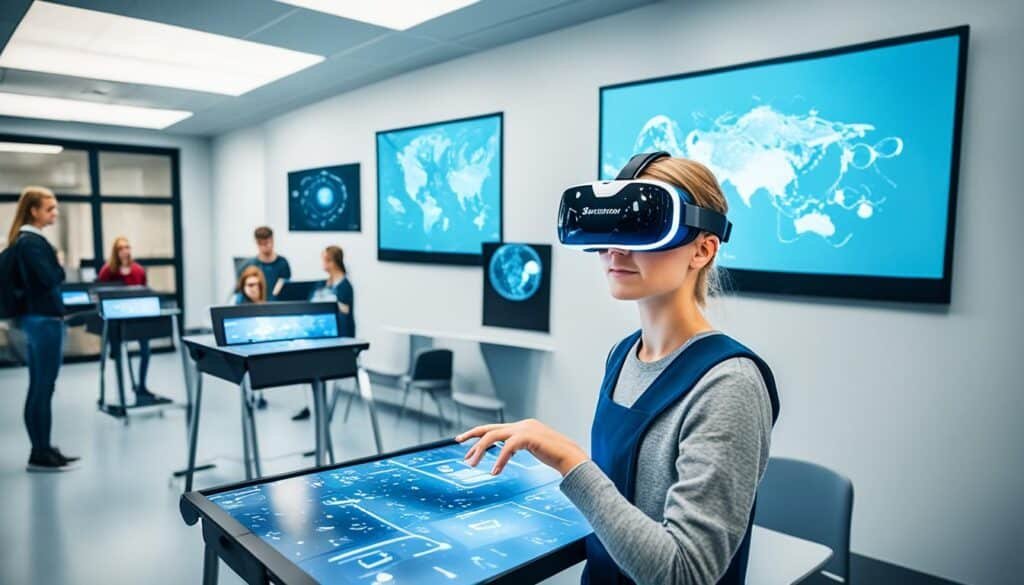
The world of education is changing fast, and new tech trends are leading the way. Artificial intelligence in education and virtual and augmented reality are changing how students learn and interact. These new tools are making courses more engaging for students and helping them connect with teachers and peers in new ways.
Artificial Intelligence in Education
Artificial intelligence (AI) is a big deal in education right now. It’s helping teachers make courses that fit each student better. This tech is cutting down on teachers’ workloads and making learning more engaging for students. Experts believe AI’s role in learning will only get bigger, offering more personalized learning experiences and smarter ways to teach.
Virtual and Augmented Reality Applications
Virtual reality (VR) and augmented reality (AR) are making learning more exciting than ever. Students can now interact with lessons in fun and interesting ways, like visiting historical sites virtually. As these tools get easier to use, they’re becoming more common in classes. This change brings about learning in ways that were unimaginable before, making study materials more engaging and understandable.
Learning Analytics and Adaptive Learning
Learning analytics and adaptive learning are also on the rise. These systems use data to give students feedback, adjust lesson paths, and deliver content better suited to their needs. This push towards using data for education helps teachers teach more effectively. It allows them to focus on what each student needs, which can boost everyone’s learning outcomes.
| Trend | Description | Impact |
|---|---|---|
| Artificial Intelligence in Education | Integration of AI-powered tools and platforms to personalize instruction, reduce faculty workload, and improve student engagement. | Unlocks new possibilities for personalized learning and data-driven decision-making in education. |
| Virtual and Augmented Reality Applications | Immersive technologies that enable more interactive and visually compelling learning experiences. | Fosters innovative learning experiences that captivate and inspire students. |
| Learning Analytics and Adaptive Learning | Data-driven insights and systems that provide personalized feedback, adjust learning pathways, and optimize content delivery. | Empowers educators to make more informed decisions, tailor instruction, and improve learning outcomes. |
Also Read: What Are The Requirements For A Bachelor Of Education Degree?
Conclusion
Technology plays a crucial role in changing the future of education. It helps make education more accessible, inclusive, and personalized. Through online platforms and virtual classrooms, it brings educational opportunities to more people.
It also improves how we collaborate and communicate, making the world smaller. This transformation is everywhere in the educational world.
We need to prepare students for tomorrow by teaching them vital skills like digital literacy and how to work in virtual teams. Learning from data and adapting teaching to fit each student also promises great benefits.
But, there are challenges when using tech in education, like making sure everyone has access, training teachers, and keeping information safe. It’s important to solve these problems to give everyone a fair chance at a good education.
With new tech trends like AI, as well as virtual and augmented reality, we are pushing education forward. It’s essential that we help students understand and use these tools. This way, they will be ready for the future and have fun while learning.
FAQs
Q: How does technology impact education?
A: Technology has transformed the education sector by enabling students to engage in interactive learning experiences, access online resources, and cater to various learning styles.
Q: What role does technology play in shaping the future of education degree?
A: Technology facilitates personalized learning, promotes engagement, and enables collaboration among students and educators in the educational experience.
Q: How do emerging technologies benefit teaching and learning in the classroom?
A: Emerging technologies such as adaptive learning platforms and interactive simulations enhance traditional teaching methods, allowing students to explore and take ownership of their learning.
Q: How has online learning impacted the educational environment?
A: Online learning platforms offer virtual learning opportunities, real-time feedback, and access to educational materials, providing students with quality education in a digital learning environment.
Q: What are the advantages of using technology in the classroom?
A: Technology allows students to engage, interact with simulations, and work together, creating engaging and interactive teaching methods that cater to diverse learning styles.
Q: How does technology enable students to make the most of their learning experience?
A: By using technology in the classroom, students are able to explore, learn in an effective manner, and develop skills that prepare them for future educational and professional endeavors.
Q: In what ways does technology impact the relationship between teaching methods and learning outcomes?
A: Technology enables educators to adopt strategies that engage students, utilize online resources, and create a dynamic learning environment that fosters effective learning and promotes student growth.



